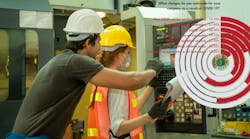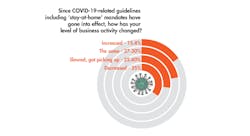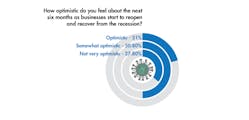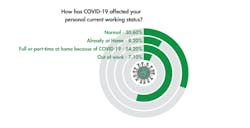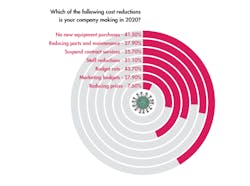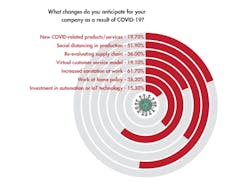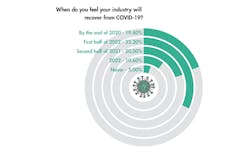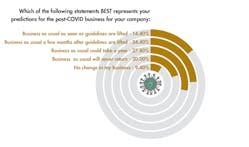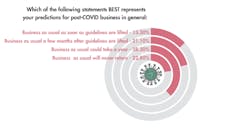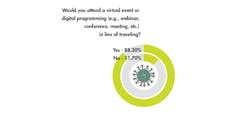The global COVID-19 pandemic has changed the way engineers have worked and the way their companies operate. And while there are strong expectations their own business will return to something close to normal in the next 12 months, their optimism for the rest of the economy is more tempered.
These are the key findings in a new study of the Design Engineering group of Endeavor Business Media. This group includes Electronic Design, Electronic Sourcebook, Evaluation Engineering, Hydraulics & Pneumatics, Machine Design, Microwaves & RF and Source Today. The results were part of a larger study conducted across 78 Endeavor Business Media titles.
Engineering leaders expect recovery to start to take hold in 2021, with 32.2% seeing a rebound in the first half of the year and another 20% seeing recovery in the second half. Respondents are more optimistic that their own business will return to normal than for the economy as a whole. While 38.8% expect normal working conditions to resume on or shortly after the COVID-19 guidelines are lifted, 27.8% expect that normal business conditions could take a year to resume and 20% don’t ever see a return to normal.
By comparison, while 34% of engineers think there could be an overall return to normal for all businesses, 38.3% said that could take more than a year and 22.8% said it would never return to normal.
When they do return to that new normal, engineers expect there to be changes in the way their business operates. These changes mainly concern sanitation, with 61.7% expecting an increased emphasis in that area, and social distancing, with 51.9% expecting continuing rules about maintaining worker spacing. And in one of the more surprising pieces of data, while 36% expect a re-evaluation of their supply chain and 19.1% planning a virtual customer service model, just 15.3% expect a company investment in automation or Internet of Things technologies.
While about 35% of engineers said business activity has declined since “stay-at-home” guidelines were widely implemented, 27% have seen no change in business and 15.4% have seen an increase. Slightly more than half of respondents (50.8%) say they are optimistic about the next six months as business reopen, a higher level of optimism than expressed in the overall Endeavor survey (43.7%).
In many businesses, work-at-home guidelines have become a new normal, and 54.2% of engineering respondents said they now are working at home full-time or part-time as a direct result of COVID-19, while 30.6% are working normally, either in the office or in customer-facing roles in the field. Just 8.2% report they already were working from home full-time. The engineers said their company would be expanding the work-from-home policy for the future, with 38.2% expecting changes in that procedure even after restrictions are lifted.
Company officials said there either were prepared for some sort of business disruption or were quickly able to adapt. A disaster plan was in place 44.2% of businesses, although 37.1% needed to update the plan to deal with the specific impact of COVID-19. Another 19.1% quickly developed a response plan, and 10.9% are now implementing a plan.
To meet the pandemic challenges, a number of businesses altered their purchasing, contract, employment and marketing plans. The two biggest areas of reductions were in overall budget cuts (43.7%) and eliminating new equipment purchases (41.5%). Companies also cut back on personnel, as 31.1% experienced either staff reductions or furloughs as a result of the pandemic.
One big area of changes for the near future is the way engineers seek out and obtain information. While 62.8% said they have no travel planning in the next six months and just 8.9% are back to their pre-COVID-19s travel schedule, 88.3% of respondents said they would attend a digital webcast, conference or meeting instead of traveling.
